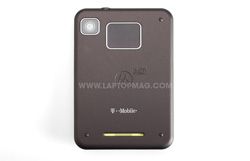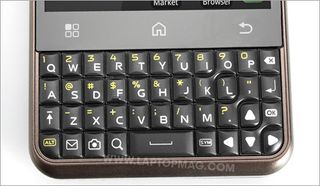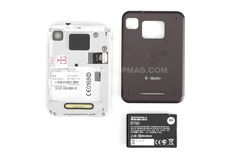Laptop Mag Verdict
This affordable Android phone has a cute design and a good physical keyboard but it's lack of speed and low-res screen are turn-offs.
Pros
- +
Good physical keyboard
- +
Runs Android 2.1
- +
Includes two batteries in the box
Cons
- -
Low 320 x 240-pixel resolution
- -
Motoblur runs a bit slow
- -
Some popular apps don't run or look weird
- -
Runs a little hot
Why you can trust Laptop Mag
When you name a phone "Charm," it sure as heck better work like one. With a BlackBerry-like look , this compact device is the first Android phone in the U.S. with a phsical keyboard you don't need to slide out to access. On paper, it's a tempting buy for heavy texters who want a full Web experience. We also like the relatively low $74.99 price and Motoblur's social networking features. However, the Charm's low-resolution screen and sluggish performance make this handset less compelling than T-Mobile's other Android offerings.
Design
The Motorola Charm is an attractive little device that resembles a BlackBerry--or a Peek--with a portrait screen up top and a physical keyboard below. It's a design that many business-minded folks like because it looks professional and emphasizes quick messaging. It feels solid in the hand, and the plastic components don't feel cheap.
With the body measuring 3.9 x 2.7 x 0.5 inches, the Charm's height is smaller than other Android phones, but it's a little thick. It also feels slightly heavy for a small phone, weighing in at about 4 ounces. The top of the Charm features a power/standby button and a 3.5mm headphone jack. The left side features a MicroUSB port for charging and syncing, and at the top you'll find a volume rocker. A microSD card slot can be found under the back cover, and the phone comes with a 2GB card.

Click to enlargeThe back of the Charm features a basically useless trackpad (called "Backtrack" by Motorola), which was last seen on AT&T's unimpressive Backflip. There's no real incentive to navigate using the Backtrack when you can just navigate the touch screen with your finger.
The Charm became a little hot in our hand after periods of heavy use. It was uncomfortable on the side of our face after being on a call for 15 minutes. On the bright side, it could warm you up during the winter.
Display
The most disappointing aspect of the Motorola Charm is its 2.8-inch capacitive touch screen. The QVGA screen has a dated resolution of 320 x 240, and in turn it displays fuzzy text, muted colors, and low-grade photos and videos. The glass capacitive touch screen is very responsive and you can smoothly pinch-to-zoom on the web, but that isn't enough to make up for it being hard to read.
Keyboard
The Charm's QWERTY keyboard is comfy and responsive, and compares favorably with BlackBerry devices such as the Bold 9700. The slightly raised plastic keys are easy to press. We sent off texts and e-mails quickly after a few minutes of practice. We wish there were a little more spacing between the keys, however, but that potential extra space is at least used by adding physical buttons for the universal inbox, camera, and universal search. Still, those buttons may have been better served being common symbols (like @). You can use the virtual keyboard, but most users wont' bother.

Click to enlarge
User Interface

Click to enlargeThe Charm runs Android 2.1 with the Motorola's custom Motoblur skin; it's essentially a shrunken-down version of the skin on the Droid X . You can swipe left and right to access any of your seven customizable home screens, which can be filled with apps and widgets.
We're generally fans of MotoBlur and its ability to keep people closely connected to e-mail and social networks. Unfortunately, running a complete set of widgets with MotoBlur makes the phone run slowly with the Charm's 600-MHz processor.
Specs and Performance
Since the Charm's processor and 512MB of RAM have difficulty running the intensive Motoblur skin, the phone felt a little sluggish, especially when streaming music from Pandora and while alternating between the web and the social networking widgets. Performance improved when we turned off the live wallpaper and disabled UI animations, but should you shouldn't have to sacrifice these things.
Web, E-Mail, and Messaging
Because of its small, low-res screen, surfing the web on the Charm is a bit of a chore on the 2.8-inch display. The stock Android web browser generally performed well, when you don't ignore how slightly fuzzy everything looks. It mostly opened WAP pages instead of desktop pages, but that helped because of the cramped space. The Dolphin HD browser works a little better than the stock browser because you can hide the notifications bar and get a little more browsing room.
Connectivity speeds were very good over 3G but not so great over EDGE. Using the SpeedTest.net app, we averaged 1,078-Kbps downloads and 343-Kbps uploads over 3G. With EDGE, downloads averaged 32 Kbps and uploads averaged 78 Kbps. Using the Charm's 802.11b/g/n Wi-Fi, pages loaded quickly. Laptopmag.com, a full desktop site, popped up in 15 seconds and ESPN's mobile site loaded in 5 seconds.
Like other MotoBlur Android phones, the Charm provides access to your personal or work e-mails by using the Gmail app and a separate E-Mail app for corporate or other personal e-mails. It's annoying to have it all in several places, but such is the price of a Google-centered OS. Text messaging using the Messages app works great with the keyboard, and it features a universal inbox for things like Facebook and Twitter messages.
Apps and GPS
It looks like Motorola is fully committed to its Motoblur Android skin. MotoBlur's intention is to keep you connected to friends and family via social networking, messaging, and e-mail by providing lots of widgets and the ability to centralize Twitter and Facebook accounts with it. MotoBlur's widgets are decent, but they aren't as polished as the ones HTC includes with its Sense UI on its Android phones.
While the Android Market has more than 65,000 apps, some cannot be downloaded onto the Charm because they don't support the Charm's screen resolution. For apps that can be downloaded, the resolution sometimes makes the apps look weird, and an app's orientation may switch from screen to screen. For instance, the official Twitter app's home screen makes you tilt the phone 90 degrees to read it and then back to normal for reading updates. Bonsai Blast, our favorite free game on Android, works only with the screen tilted 90 degrees. Can you say awkward?
For turn-by-turn GPS directions, you can use free Google Maps Navigation. The Charm worked well enough, but the app's performance was a little slow. If you have to make a quick series of turns, that slowdown could potentially get you lost.
Music, Videos, and Photos

Click to enlargeThe Charm is average at playing media and below average when capturing it. The 3.5mm headset jack, which makes it easy to use a pair of standard headphones for listening to music, is nice to see. Tracks on the so-so stock music player--which supports supports MP3, AAC, and WMA files--sounded full using a decent pair of headphones, and the app pulls lyrics from TuneWiki. Because of the phone's screen resolution, however, some of our favorite music apps such as Rhapsody and MOG didn't appear in the Android Market. The free Pandora app played smoothly over 3G and Wi-Fi.
On the movie front, the Charm records bland, not-so-charming 352 x 288 videos at 10 frames per second; you won't be making any YouTube masterpieces with this handset. For video playback, the device supports MPEG4, H.264, and WMV files.
The 3-megapixel camera on the Charm is a lackluster offering for today's Android phones. Photos looked grainy, and there is no way to change white balance or other advanced settings. The only things you can do are tweak the digital zoom or engage a panorama assist feature. On T-Mobile, the competing Samsung Vibrant takes better photos with its 5-MP lens. For phones with a similar form factor, the BlackBerry Bold 9700's 3.2-MP shooter is better overall too.
Call Quality, Reception, and Battery Life
Call quality on the Motorola Charm sounded clear but a little flat. Callers on the other end complained that we sounded undefined and slightly fuzzy. The speakerphone was good enough to be used in a noisy environment but a little harsh at the loudest volume. Reception was above-average. T-Mobile reception inside a New York City apartment was generally OK, and the Charm had good 3G signal throughout it.

Click to enlargeInterestingly enough, the Charm comes with two batteries. The standard 1170 mAh battery that came inside the phone lasted for 3 hours and 36 minutes on the LAPTOP Battery Test (web surfing over 3G). The "extended" battery--which bulges out, requiring a larger back cover--lasted a longer 4:44, and both times fall below the average of 5:24. It's nice to have a spare battery if you run out of juice.
Pricing and Value
The Charm rings in at $74.99 with a two-year contract from T-Mobile. On its face it seems like a reasonable deal--$75 bucks for an Android-powered phone with a good physical keyboard. But considering that you're paying the same price per month for service with the top-of-the-line Samsung Vibrant, there's very little difference in cost over two years. The Vibrant costs $199.99 direct from T-Mobile with a two-year contract. (Even better: Amazon is selling the Vibrant for $49.99 with a new 2-year contract with T-Mobile.)
The Samsung Vibrant is our Editors' Choice smart phone on T-Mobile for good reasons--it has a stunning 4-inch AMOLED screen, a 1-GHz Hummingbird processor, and Samsung's helpful TouchWiz skin over Android 2.1. For those who want an Android phone with a physical keyboard, the T-Mobile myTouch 3G Slide (at $179.99 with a two-year agreement) gives you more viewing space with its 3.4-inch screen, better overall performance, and a full slide-out keyboard. For business-savvy users who want a physical keyboard, the BlackBerry Bold 9700 edges the Charm out for its long battery life, just-as-good keyboard, and higher resolution screen.
Verdict
We think a lot of messaging fiends will appreciate the Motorola's Charm's unique design. It's nice to be able to fire off e-mails and texts without having to slide a keyboard down or rely on a touch keyboard. The $74.99 price is also attractive. However, the Charm's low-res screen and sluggish processor can't handle everything Motoblur tries to do, let alone Android. If you want a Google phone paired with T-Mobile's reasonable pricing plans, the more powerful Samsung Vibrant is currently the best option. But if you want something more compact and a better typing experience, the Charm is worth a look.
Motorola Charm Specs
| Audio formats supported | AAC+, AAC, WMA, MP3, AMR-NB |
| Bluetooth Type | Bluetooth 2.0 EDR |
| Brand | Motorola |
| CPU | 600-Mhz |
| Camera Resolution | 3 MP |
| Carrier | T-Mobile |
| Company Website | http://www.t-mobile.com |
| Data | EDGE/HSPDA |
| Display (main) | 2.8 inches/320 x 240 |
| Form Factor | Candy Bar |
| GPS | Yes |
| Internal Memory | 512MB |
| Memory Expansion Type | microSDHC |
| Networks | WCDMA 1700/2100, GSM 850/900/1800/1900 |
| Operating System | Android 2.1 |
| Ports | microUSB, 3.5mm headphone |
| RAM | 512MB |
| Size | 3.9 x 2.7 x 0.5 inches |
| Talk / Standby Time | Standard battery: 6.5 hours/11 days Extended battery: 8 hours/14 days |
| Video formats supported | WMV, MPEG-4, H.264 |
| Weight | 3.9 ounces |
| Wi-Fi | 802.11b/g/n |
